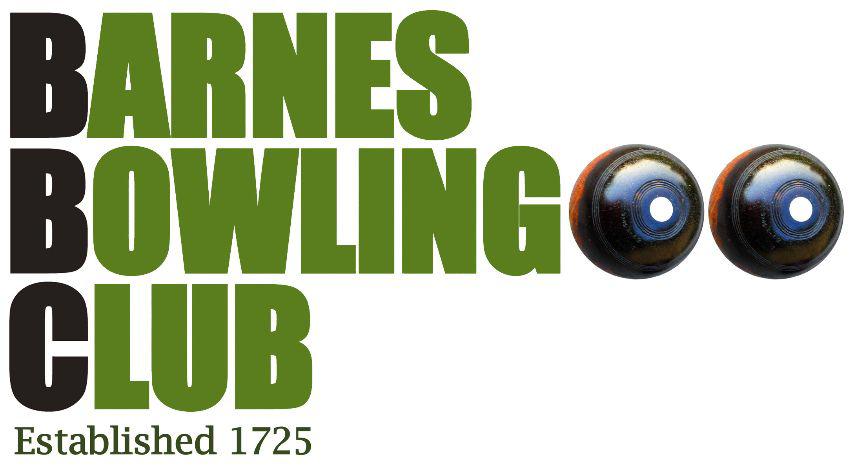The Barnes Bowling Club is located in a walled enclosure situated at the rear of the Sun Inn at Barnes. The object of the Club is to play and preserve the ancient game of bowls in a historic environment on the very spot where bowls has been played for centuries.
HOW OLD IS BARNES BOWLING CLUB?
The game played by the Barnes Bowling Club dates back at least to the early 18th century, and may even reach back to medieval times. What is apparent, to even the most casual observer, is that the form of bowls played here is substantially different from the game seen elsewhere in Britain today.
A comparison between the rules of this club and those of the English Bowling Association ( which date from 1840 and govern most present day bowls clubs ) reveals several marked differences.
At Barnes each player uses a pair of wooden bowls, not a set of four made of henselite that other clubs now use. Our woods have an unusually high bias (graded 12 or 13), unlike Association woods that have a much lower bias.
We do not play on a completely flat green, or even a ‘crown’ green as in northern clubs – our game is played from corner to corner, the edges of the green being banked up to provide perimeter slopes to tempt and test the skill of the players.
All of this indicates that the unique game played at The Sun in Barnes is a survival from a time prior to the Association’s national rules, drawn up in 1840 by William W Mitchell. Whereas most clubs throughout the country adopted the strict new Mitchell code, the club at Barnes, it seems, decided to continue on its own maverick way.
Other clubs with truly ancient origins – such as Chesterfield (c.1290), with its “oldest green in the country”, and Southampton (c.1295) – play a game similar to our own, and this has led many to believe that the green at Barnes could also rank among the oldest in the country. Records suggest that our green pre-dates the coming of the Sun Inn, a pub being established on this spot by the early 1800s, when the property was bought by local brewer John E. Waring.
Back in 1723, according to one record, there were on this site “ two customary dwellings, two gardens, a barn, one stable and 3 orchards.” One of these private gardens may have been the bowling green dated by The Shell Book of Gardensto the 15th century.
During the 17th and 18th centuries, puritanical attitudes frowned on games such as Bowls being played in public places, but by 1805 a change of mood allowed the Sun pub to incorporate the private green into its public premises.
Elsewhere in the country, there were a handful of other bowls clubs that continued to play by the old pre-1840 rules. The club possesses a pair of wooden bowls bearing a plaque commemorating a game played in 1892 between the Kings Arms at Dereham and the Victoria Arms at Norwich. It is known that the Dereham club, established before 1858, played a game very similar to our own, using wooden bowls with a high bias.
MODERN TIMES
Club records for the early 20th century show a maximum annual membership of forty: all-male, and drawn from the professions and from the ranks of managers in industry and commerce, reflecting the jobs of the local parishioners. Understandably, membership dwindled during the war years and no matches at all were played in 1917 – the only ‘quiet’ year in the club’s history. By 1918 membership had halved and subscriptions were increased. When in 1922 the landlady of the Sun Inn announced her intention of converting the green into a tennis court, the local paper was outraged: ”It seems little short of sacrilege to abolish this historic green which cannot be replaced.”
Press coverage of local consternation had the desired effect and the survival of the club was secured. “Alfresco concerts” were held on the green, “sumptuous sit-down teas” were enjoyed at weekends, and away matches were organised against clubs in Ealing, East Sheen and Boileau. Despite “fly-bombs curtailing practice” during the Second World War, the club has since gone from strength to strength. In 1994 membership was increased to a maximum of seventy, and in 1991 women were invited to become members for the first time.
All 110 present members pay a yearly subscription fee and are eligible to enter many of the internal club competitions for old established trophies. These include the Shield, the Cup, the Mansers, the Pairs Cup, the Plus Cup and the Murray Johnson ‘winners play-off’ Cup.
The season runs between the end of April and the beginning of October, with floodlights used in the evenings. The club hosts many social functions, including ‘Internationals Day’ when sport meets party. Over the years membership has included people from the entertainment industry such as Roger McGough, Alan Price, Roger Chapman, DJ’s Richard Skinner, Larry Page and Mike Reid; guest appearances have also been made by Tom Jones, Charlotte Rampling, MPs Robin Cook and Chris Patten, and many others.

